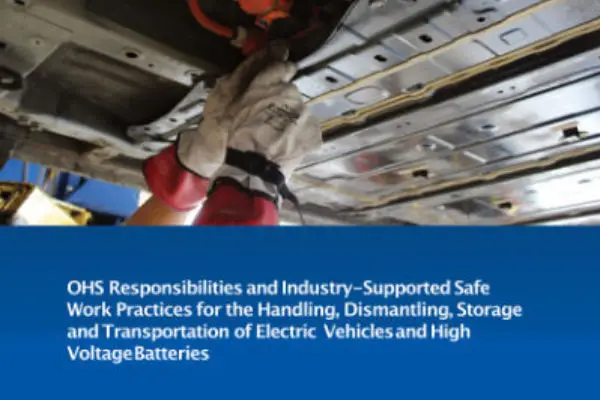The ARA, through the support and cooperation of WorkSafeBC and industry partners, has developed comprehensive guidelines for the safe handling of electric vehicles (EVs) and high voltage batteries for the recycling and towing and recovery industries. Guidelines and protocols, along with other tools and resources, are available for download from ohs.ara.bc.ca.
When Toyota launched the first Prius Hybrid in the 1990s, it started electric vehicles on the road from obscurity to mainstream acceptance. Tesla introduced the first modern era all-electric production vehicle to the market in 2008 and the Nissan Leaf and Chevrolet Volt were introduced in 2010. Ten years later, EVs make up nine percent of all light-duty vehicles sold in the province. More than 30,000 electric vehicles are now on the road in B.C. and the provincial government has set a goal of 100 percent of all new vehicle sales being zero-emission by 2040.
Increased EV sales will result in more EV batteries requiring end-of-life (EOL) management. Even now, as more consumers and businesses make the shift toward driving EVs, the number of EV batteries reaching EOL has started to increase and is projected to grow dramatically in the next five to ten years. As their numbers grow, it is essential for towers and recyclers to understand how the hazards associated with electric vehicles differ from those with internal combustion engines.
The automotive industry is undergoing a transformation in the way vehicles are being designed and manufactured, hence the requirements for their EOL management placing additional constraints on the infrastructure needed to support them. A series of fires at material recycling facilities in the last few years has raised concerns about the dangers of storing NiMH and Li-ion batteries. While there have been no reported fires caused by electric vehicle batteries to date at any automotive dismantling facility in B.C., EV batteries present an increased level of risk because fires involving them are more difficult to control. While gas tanks can be emptied, EV batteries create their own oxygen, so they can start fires anywhere and at any stage of the process. In May 2019, an EV that had been partially submerged in saltwater and recovered caught fire while being transported by a tow truck. EV batteries in EOL vehicles still carry a charge. Even when the battery is fully discharged they can still leak electrolytes.
The ARA conducted a preliminary survey of OHS practices related to the storage and handling of EVs. Results of this survey strongly suggest there is a need to develop a comprehensive set of safe work procedures and practices specific to the automotive dismantling and towing and recovery industries. Almost all survey respondents reported they did not have an active OHS program in their workplace to properly manage EVs and they lacked proper orientation for new workers. Additional industry feedback suggests there exists an inconsistent application and understanding of safe work practices in the industry when it comes to handling EVs.
The ARA approached WorkSafeBC for the purpose of developing resources in order to promote safe work practices for the transportation, dismantling, and storage of EVs. WorkSafeBC approved the project in January 2020 and we are pleased to announce the project has been completed and the guidelines are available to industry. A limited number of printed copies will be published and made available to ARA members.
The guidelines cover a wide range of important topics, including the legal responsibilities of workplace parties; meeting due diligence; EV hazard identification and risk assessment strategies; a section on the various types of electric vehicles (HEVs, PHEVs, and BEVs), and identifying the types of batteries
used with each (NiMH, Li-ion); as well as safe work procedures including:
- Conducting a scene assessment for a recovery involving an EV
- Securing and disabling an EV
- Loading and transporting an EV
- Water recoveries
- Receiving an EV into a recycling facility
- Dismantling an EV
- EV transportation and storage
Additional information provided includes guidance on effective OHS supervision practices, appendices that include tailgate meetings, weblinks, references, and a section that will assist the employer in utilizing the guidelines as a resource for training (e.g. to meet the requirements in section 3.23 of the OHSR regarding initial training of new and young workers).
The guidelines, “Occupational Health and Safety Responsibilities and Industry-Supported Safe Work Practices for the Handling, Dismantling, Storage and Transportation of Electric Vehicles and High Voltage Batteries,” are available for download from the ARA’s OHS website and additional information and training concerning EVs will be available in the near future, so watch the ARA News for the latest updates.
